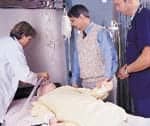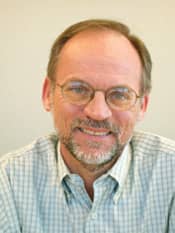Treehouse by Design: Trail’s Edge Camp, designed by members of the University of Michigan’s School of Architecture and run by its Health System, is an adaptive playground—complete with accessible treehouse—for ventilator-dependent children.

A first-time visitor to Trail’s Edge Camp, Mayville, Mich, will see everything one expects to see at camp—kids riding horses, fishing, climbing trees, hiking, swimming, and playing pranks on each other. But Trail’s Edge Camp is not like other camps. That is because all of its campers are ventilator dependent. “The reaction of people who walk in, and even people who think they know what they’re going to see, is an emotional catharsis,” says Mary Dekeon, RT, camp director and a founder of the Trail’s Edge Camp. “You see these beautiful kids—they’re not patients in the hospital—they’re active, they’re driving their power chairs around like maniacs, they’re laughing, they’re having a great time, and it strikes you that they’re real children that have been given this horrible hand of cards and they are making the best of it.”

The 200-acre camp, which is operated by the University of Michigan Health System, is designed to give ventilator-dependent children an entertaining, overnight camp experience in a medically supervised setting. Each year 30 kids—15 boys and 15 girls aged 4-19—get to leave their family for a week and experience life on their own. About 30% of the campers do not use wheelchairs.
Even with its obvious benefits of giving caregivers a break and their children a taste of independence, Dekeon knows that the decision to send a child to the camp is a tough one. “There are tons and tons of ventilator-dependent children out there, but it’s a very courageous family that lets their child come to camp for a week,” says Dekeon. “It really requires so much trust on the family’s part, and unfortunately, the most overprotected kids who could use it the most don’t ever get to come.”
But parents have little to worry about. The camp is well staffed with medical personnel.
Going to Camp
When the kids arrive at camp, they are paired with an adult—usually a respiratory therapist—who will be with them throughout their waking hours. The staff to camper ratio is 3 to 1. Most of the volunteer staff come from the University of Michigan Health System. In the evenings, medical personnel stay in the cabins with the children, ready to address any of their medical needs. Though most of the campers are in wheelchairs and all are on ventilators, they are required to be medically stable and neurologically intact to attend the camp. The camp is free for the campers and is funded through an annual golf outing and by the Friends of the University of Michigan Medical Hospital.
The camp, like all summer camps, is the source of lifelong friendships among campers and between campers and their adult companions. Since the return rate for the adult volunteers is about 75%, campers are usually reunited with their partners from the year before.
Kurt Riek, RRT, has been a cabin respiratory therapist at the camp for the past 5 years. Though a respiratory therapist, he had qualms about being a staff member, but that changed once he arrived at the camp. “I was really apprehensive, I didn’t know what to expect, I hadn’t had much interaction with kids with disabilities, and I didn’t know what that entailed,” he says. “And when I first went to camp, there was a part of me that felt real sorry for these kids. But your attitude changes toward the end of the week, and you realize how inspiring they are. They absolutely have no limitations even though they are on ventilators and in wheelchairs. I think that’s what keeps me going back every year, just their inspiration, and the way that they keep themselves going.”
Each day at the camp resembles a day at a facility for able-bodied campers in most details. The campers have a scheduled activity—usually designed by the camp physical therapists—in the morning, which can range from horseback riding and outdoor scavenger hunts in good weather to tie-dyeing and other less intense activities in bad weather. The campers have lots of free time and are not required to take part in any of the structured activities. Free time also gives the kids ample opportunity to play pranks and douse each other with their camp-issued squirt guns.
The entire camp is fully accessible—all buildings are flush with the ground—and loaded with adaptive technology, a benefit derived from working with the University of Michigan’s School of Architecture. Its graduate students have been involved for years in developing the camp’s adaptive technology and making it accessible to all the campers whether they are in wheelchairs or ambulatory. One of the biggest challenges the architecture graduate students recently solved was the design of an all accessible freestanding treehouse.
In the Trees
The $100,000 treehouse, which will be dedicated in June, is fully accessible to all the campers. Everyone enters the 32-x-12-foot structure the same way, via a harness that the campers use to lift themselves into the treehouse with a pulley system. When they reach the main platform, which is fully finished, the campers are transferred to a rail and chair system that allows those who use wheelchairs full access to the structure.
Once situated in the treehouse, the campers will find a space designed specifically for a kid or kid-at-heart. Several of the windows are made of the same kind of glass as that found in funhouse mirrors, distorting the outside view. There are kaleidoscopes, a water balloon launcher, and a bookcase full of material for quiet or rainy days.
It is not unusual for Trail’s Edge Camp to change the lives of the campers, making them more independent. But the camp has changed the lives of its volunteer staff as well.
Life-Changing Experience
Riek credits the camp with making him a better person. “I think it’s the single best thing I have ever done in my life; it is truly a life-changing experience,” he says. “I don’t think I was so compassionate beforehand, even in my professional [life]. It just has helped me become more compassionate.”
Dekeon also believes it has changed her life and has continued to breathe new life into her career as a pediatric respiratory therapist at the University of Michigan Health System. “If you work in a pediatric intensive care unit as long as I have—which is more than 20 years—you get burned out on the tragedy and the sadness,” she says. “And I see the kids past that. When you see a baby with multiple anomalies, you say to yourself, ‘My god, why are we doing this?’ I know the answer why. And I guess that is the biggest thing of all: If you have a career in pediatric medicine, [the camp] will tell you why you’re doing it.”
C.A. Wolski is associate editor of RT.









